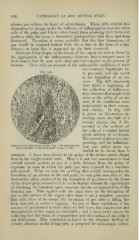Page 846 - My FlipBook
P. 846
856 PATHOLOGY OF THE DENTAL PULP.
abscess just within the layer of odontoblasts. These cells exhibit less
disposition to change under the influence of inflammation than the other
cells of the pulp, and I have often found them retaining their form and
position when the tissue in immediate juxtaposition witli them had been
destroyed. Therefore, it seems probable that the first formations of
pus would be retained behind them for a time in the form of a tiny
abscess ; at least, this is suggested by the facts observed.
Abscesses lying deeper in the tissue of the organ are seen to form by
the aggregation of the inflammatory elements into a compact mass or
little masses that lie near each other and run together in the process of
increase. These cells, on account of the unfavorable conditions of their
environment, degenerate in-
Fig. 453.
to pus-cells, and the result
is the formation of an ab-
scess. Fig. 450 represents
very fairly a beginning of
the collection of inflamma-
tory elements that might well
serve as the nidus of an ab-
scess if the conditions were
unfavorable to their contin-
ued vitality. In Fiff. 453
is given an illustration in-
eluding about the half of a
minute abscess that I dis-
covered in the sections of
the pulp of a central incisor
about midway of its length.
The coronal portion was sup-
purating, and the inflamma-
Abscess within the Tissues of the Pulp. The field includes
tion was rather more ex-
about one-half of the little pocket of pus (X 2oU).
tended in its tissue than is
common. I have seen abscess in the pulps of the molars much oftener
than in the single-rooted teeth. Here it is not very uncommon to find
several minute pockets of pus at a little distance from the point of
exposure in cases in which the pulp has been exposed for a consider-
able period. When we note the swelling that usually accompanies the
formation of an abscess in the soft parts, we can gain some idea of the
destructive effect produced by the formation of an abscess in the tissue
of the dental jjulp, encased as it is in the dentine Avithout the opportunity
of obtaining the increased space necessary for the accommodation of the
forming pus. This applies with the same force to the formation of
})us on the surface of the organ when there is not a complete exposure
that will allow of its escape, the formation of pus after a filling has
been inserted, or under a capping. In any of these conditions, if the
amount of pus formed is more than can find room, the compression and
strangulation of the organ are inevitable ; and I have every reason for
believing that this form of strangulation and destruction of the pulp is
not infrequent. This conclusion is based on the frequent finding of
minute abscesses in the living pulp as prepared for microscopic exami-


